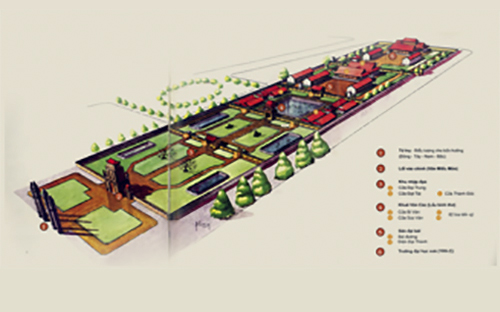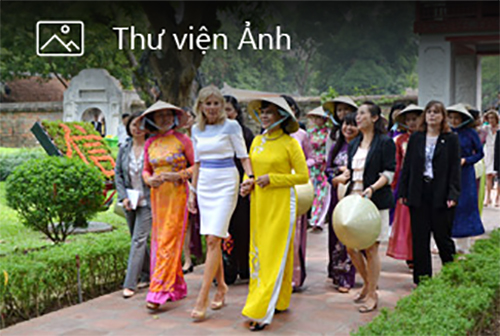THE STONE STELAE AT VAN MIEU - QUOC TU GIAM
Van Mieu – Quoc Tu Giam currently has 82 preserved doctoral laureates’ stelae, which bear the names and places of birth of 1307 graduates from 82 royal examinations which were held from 1442 to 1779 under the Le and Mac dynasties.
The laureates’ stelae were firstly erected at Van Mieu – Quoc Tu Giam in 1484 under the reign of the King Le Thanh Tong (1460-1497). This event was recorded in Dai viet su ky toan thu: “In the year of Giap Thin, the 15th year of the reign of Hong Duc (1484)… Autumn, on the 15th day of the 8th lunar month, the stelae were set up with the inscriptions of the names and birth places of the laureates from the examination held from the year of Nham Tuat, the 3rd year of the reign of Bao Dai (1442), under the King Le Thai Tong during that dynasty and up to the present.…”. It was such a special event which has increased the great spiritual value of Van Mieu – Quoc Tu Giam.
82 stone slabs remain at Van Mieu – Quoc Tu Giam, which have been set up for nearly 300 years from 1484 to 1780. Each stele was erected to engrave the names and birth places of the laureates of each examination. The laureates’ stelae were erected during different periods. In 1484, the King Le Thanh Tong ordered 10 stone stelae to be set up for the examinations held from 1442 to 1484. Only 7 stelae erected during that time remain today. Later, 5 stelae were set up from 1487 to 1529 in 1487,1496, 1513, 1521, 1529 and 2 stelae were erected in 1536 under the Mac dynasty. The maximum numbers of stelae were set up in 1653, 25 stelae were erected for the examinations organized from 1554 to 1653. The third period of the erection of 25 stelae was completed in 1717 for the examinations held between 1656 and 1717. The remainders of the 22 stelae were set up from 1721 to 1780. The last stele was erected in 1780 for the recording of the examination organized in 1779.
The Doctors’ stelae at Van Mieu – Quoc Tu Giam were created by talented and famous craftsmen and laureates. All the stelae at Van Mieu – Quoc Tu Giam were created in the same style, which is of flattened stelae. Each stele consists of two parts: Stele and stele sole.
+ The stele includes two main parts:
-The stele pediment is an arch shape and has various designs. The first sentence of the text which is in big ancient Chinese characters indicates the year the examination was organized.
-The main section is a rectangle engraved with the stele text in ancient Chinese characters. The text on the stele records the names and homelands of the laureates, the names and the titles of the text composer, editor, calligrapher and the time of the stele erection.
+The stele sole are tortoises with different designs and symbolize the longevity, immortality of the talented and virtuous people, the education and laureates’ stelae.
The stelae were erected in different sizes. Those stelae which were set up in the late 15th and early 16th centuries were small in size. Later, the sizes of the stelae were larger. Having been erected for nearly 300 years, the stelae were decorated with abundant designs. The largest size (height 1.75m excluding the stele sole, width 1.3m) and the smallest size (height 1.1m, width 0.7m), and the average depth of the stele is 0.25m.
The decoration of the stelae erected from 15th to 16th centuries is simple and poor. The stele pediments were decorated with the sun and spiral clouds. The edges of the stelae were engraved with flowering vines. The art styles of the stelae from the 17th to 18th centuries are diversified; the stele pediments were decorated with dragons, phoenix and the moon; the stele edges were enriched with floral motifs (flowers and leaves), human figures, birds and animals.
The motifs on the stone stelae are diversified, and reflect the development of the styles of art throughout time. Each stone stele is a real work of art, having been created by the best scholars, craftsmen and calligraphers of the era.
The special value of the stone stelae is the inscriptions in ancient Chinese characters. Each text provides a list of the laureates of that particular examination with the different ranks: De Nhat giap (first rank laureates), De Nhi Giap (second rank laureates) and De tam giap (third rank laureates). The inscriptions also give us important information on the history of the Vietnam education and examination system and a view of the nation regarding the recruitment and utilization of talented men. The idea that “Virtuous and talented men are the essential vitality of a State” is mentioned clearly in the texts on the stelae with the following significance:
- Drawing strategic policies for governors both in the past and the present that they should esteem talented people in the management of the State and the building up of the country.
- Specifying and orienting responsibility of the intellectuals for the nation. E.g. they must use their talent to serve the country and train talented men for the country
The texts on the stelae are the quintessence of knowledge of the intellectuals of different generations and the experiences of the principles for educating themselves and those of the State governance of Vietnam. In addition, the inscriptions also provide us with valuable lessons on the principles of State governance and that talented people must be given due attention and training whilst building and developing the country. The text for the stele of the first examination held in the 3rd year of the reign of Dai Bao (1442) was composed by the academician Than Nhan Trung (Title: Han lam vien Thua chi, Dong cac Dai hoc si) and affirms: “Virtuous and talented men are the essence of the State’s vitality” or “the most important and urgent question for the governance of any sovereign is how to make use of talented people” (Inscriptions for the examination in 1448). Throughout time, the policy of the State governance based on talented people is always right and affirmed. The text written for the examination held in the 3rd year of the reign of Hong Thuan (1511) by Minister of Rites, Director of the Quoc Tu Giam Le Tung (Title: le bo thuong thu Dong cac Dai hoc si kiem Quoc Tu Giam Te tuu) says: “Any Emperor who wants to govern all corners of the world in peace must seek the support of talented men”, “with regard to the philosophy of State governance, nothing is more important than talented men”. At the end of the reign of Le Trung hung, the role of talented people was still mentioned: “talented people are ho and tran trees for the nation” (Inscriptions of the examination in 1763).
The significant role of talented people for the nation is repeatedly affirmed and mentioned in almost all texts on the stelae that indicates a national policy and a key feature of State governance and is a valuable lesson for the current and following generations to follow.
To get talented people the governor should foster and train them. The way of recruitment and attraction of talented men has been reflected in the inscriptions of the stelae, which will make the country prosperous.
First of all, to recruit talented people, the State should give good opportunities for the activities of teaching and studying. It means the country must build schools, select the best teachers and try to encourage the students: “the King ordered the construction of schools in the prefects across the country and of the Quoc Tu Giam (University for the Sons of the Nation or National University) based in the capital city, recruit the best teachers and print teaching and learning materials” (Inscriptions for the examination in 1442)
However, to get real talented and virtuous people, good examinations must be organized by the government; the successful candidates of the examinations must be utilized and glorified: “the King has made the introduction of examinations to select Confucian mandarins the primary task of his governance” (Inscriptions for the examination in 1442). These procedures of organizing the examinations to recruit talented men are repeatedly mentioned in the inscriptions of the stelae, so this task is obviously considered as “a must thing to do” for the governor. There are 60 out of 82 texts covering this matter: “Top and lower ranks of talented men were selected through examinations” or “the recruitment of Confucian scholars should be through examinations” (Inscriptions for the examination in 1703), “training men of talent in schools and selecting Confucian scholars through examination” (Inscriptions for the examination in 1772).
The procedures to honor and glorify Confucian mandarins to spend all their time in study to become talented people were much diversified and those were the lessons and suggestions of the previous generation given to the one following in the State governance and the use of men of talent and virtue. Those people who were successful in their study and examinations were exempt from hard and unskilled work and the drudgery of labor; their names were inscribed on the Golden board hung in full glory at the Royal palace or at the gate of the Thai Hoc house; they were appointed to different government positions; ceremonial costumes and headwear were bestowed on the new laureates; their names were recorded in the book Dang Khoa Luc (Records of Royal Examinations) for mandarins and the literati to see and to read carefully so that they can admire the good actions presented and have the opportunity to inspire themselves. All of this will make the significance of this inscribed text more radiant, and will have close relations with the fundamentals of governance and the promotion of a civilized mode of life” (Inscriptions for the examination in 1481).
The inscriptions on the stelae provide us with lessons on how to educate ourselves and to become useful people for the homeland and the country. It is common sense that when people have achieved their goals and are glorified, they sometimes neglect their education; when they receive higher positions they could become as proud as a cock or look down upon others. In fact, some people lose their will to strive or become depraved and even lose their human dignity and it could be too late for them to be aware of what has happened to them. The inscriptions on the stelae serve as an advice, even a warning on time for contemporary Confucian scholars and for the subsequent generations. Firstly, though they succeed and are glorified they must have the dignity to be able to repay the Emperor; their actions must be in accordance with the credits and titles given to them by the Court. If they want to do those things civil mandarins must whole-heartedly care for the people and the country and know how to propose good policies to the Court…. “They must try their best to perfect their morality such as integrity, industriousness, they should be solid and pure, like “gold and gems”, must have a sense of teamwork and while serving His Majesty they should constantly be right minded” (Inscriptions for the examination in 1706).
The advice on the way to live and how to educate themselves are very sincere and detailed because they gather not only the excellent knowledge and experiences of the text composer but also the emotion for the next generations of the country: “Working at the Court, they should help the Emperor perfect his moral virtue and bring benefits to the people. When assigned to govern a region, they should become towers of strength. When holding high posts, they should display their powers of reasoning, so as to fulfill their duties as advisors to the Monarch.” (Inscription for the examination in 1691), “Old age only makes them stauncher. They should set examples for their descendants and inculcate in them fine virtues such as faithfulness, trustworthiness, honesty and self-respect. They should not use their good fortune for their personal benefit” (Inscription for the examination in 1670).
The lessons and life experiences of our ancestors and those of the knowledgeable, courageous, moral and talented generations recorded on the stone stelae, have been experienced and proved throughout time. Those lessons are extremely precious for us for all time, especially nowadays when the country has been in a period of renovation in all aspects and education has experienced many reforms and experiments. The most important task is to train and foster real virtuous and gifted people, who not only care for their generation but also think of the future generations of the country.
The erection of the stone stelae has exerted a great influence on the course of the training and education of talented people for the country. The doctoral laureates’ stelae at Van Mieu – Quoc Tu Giam have a great impact on contemporary people and those of coming generations. The name having been recorded on the stele is an encouragement for study and effort to become useful people for the country and for society. The laureates’ stelae are also a symbol and pride, success and knowledge.
Nowadays, the laureates’ stelae draw the interest of scholars, visitors and dignitaries at home and abroad. Many very important leaders from different countries visit the vestige and they highly value the benefit and significance of the laureates’ stelae.
82 stone stelae were classified as a Documentary Heritage of the World and was inscribed in the list of Memory of the World Regional Register for Asia and Pacific by UNESCO in March 2010 and a Documentary Heritage of the World and inscribed in the list of Memory of the World International Register by the General Director of UNESCO in May 2011. The 82 stone stelae at Van Mieu – Quoc tu Giam were ranked as State treasures by the Prime Minster of the Socialist republic of Vietnam on 14th January 2015. This is in recognition of the outstanding value of the laureates’ stelae at Van Mieu – Quoc Tu Giam and that of the national culture and education in particular and of the people in general.














 Guide to finding the way
Guide to finding the way
